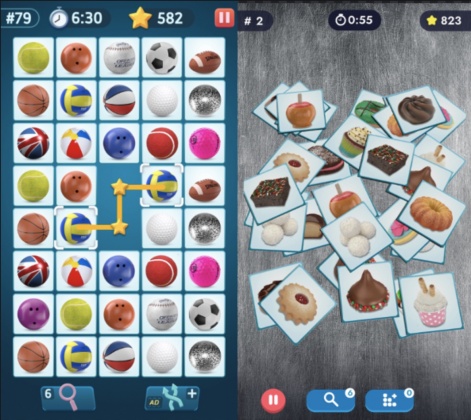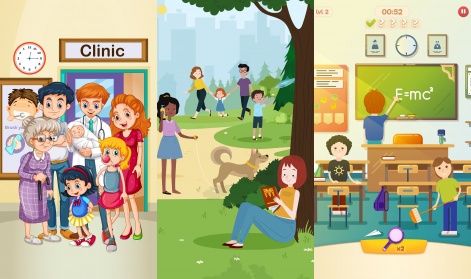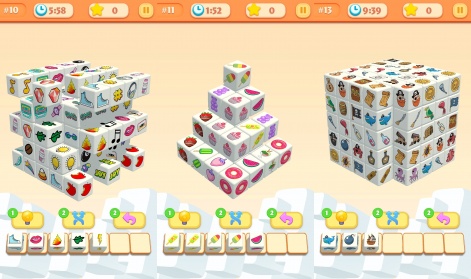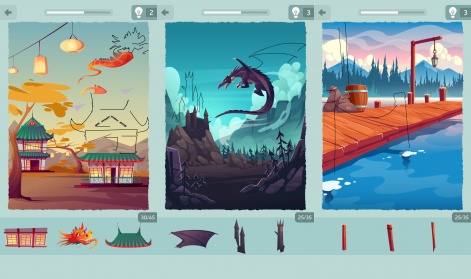Building on success: How to focus your expertise to create guaranteed hits | Pocket Gamer.biz
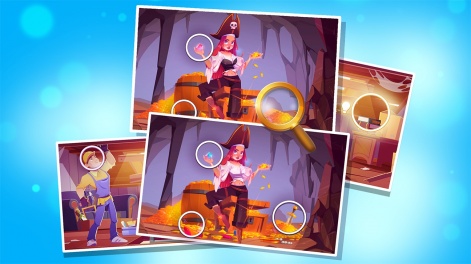
In mid-2020, Pingvi Games approached Azur Games for publishing services with two pre-made puzzle games. Despite their strong development background, it was their first foray working with a publisher.
Across several years of working together, the studio expanded and produced six successful puzzle projects, generating over $14 million in total revenue with their success thanks to their focus on a specific niche and audience.
While creating a super hit is always difficult (and often based on luck) the studio’s gradual accumulation of expertise has proven that success can be achieved in nearly 100% of cases.
In this article Milana Gelmanova, Producer at Azur Games takes a look at the road to this success across these six titles (and new game Art Master 2), together with insights from Ildus Galiulin, Pingvi Games’ Owner and CEO.
Ildus Galiulin: We started in 2010 with Flash and games for social networks. We made successful web racing games with online PvP elements and ported them to Android and iOS and this is how we gained experience in Unity.
Then we took on a large-scale hidden object game with a lot of content, but it took a very long time to launch. We began to buy traffic only after 3-4 years of development but received border metrics that couldn’t be corrected.
As a result, we switched to simpler puzzles. We made two projects and put them in the stores, and while organic traffic was coming in, there was no budget for marketing. That’s when we started looking for a publisher. We talked with different publishers, but found a connection with Azur Games right away. We were introduced to the producer, Milana, then tested both projects, signed the deal and started working.”
Game #1: Tap Tap Match, and Game #2: Match Pairs
Milana Gelmanova: Our first projects with the publisher were Tap Tap Match and Match Pairs.
Both projects involved finding matching pairs, but the implementation of the mechanic differed between the two. Tap Tap Match uses a fixed field where the cards need to be connected by a line, while Match Pairs features randomly scattered cards that need to be dragged on top of each other to make a match.
Both of the games had well-developed core mechanics, which led to good retention rates right from the start.
US market metrics:
Tap Tap Match:
• R1 50%, R7 17.5%, R30 11.7%
• LTV $0.88
Match Pairs:
• R1 41.6%, R7 18.0%, R30 8.7%
• LTV $1.39
In 2020, we managed to achieve a good CPI in our niche with Tap Tap Match at $0.48 and Match Pairs at $0.90. While a CPI of $0.50 to $1 was considered good back then, the competition in the market has grown significantly. A CPI of $1.50 is now the norm. However, success in this market requires expertise in the genre and a solid understanding of how to improve the product or offset the higher CPI rates.
Ildus Galiulin: Many games in this genre suffer from a common problem and that’s that players lose interest in them over time. Our goal was to create a game that would remain addictive even at level 500.
Our goal was to create a game that would remain addictive even at level 500
Ildus Galiulin
We knew that visuals in match puzzles could become monotonous, so we added various skins in different styles. To prevent players from getting confused with the images in Tap Tap Match, we developed a booster that allowed them to change skins during the game. This change was based on the team’s analysis of player behaviour, and it resulted in a significant increase in rewarded ad views.
We conducted various experiments with game complexity and level design to optimise player engagement and retention. To make the player onboarding process smooth, it’s important to hit the right rhythm and offer levels that gradually increase in difficulty. In essence, we look at the analytics to identify where players are struggling the most, look at the win rate, then adjust difficulty levels, level order, timers and unique items accordingly. Although we initially thought simplifying the game would be the best approach, it resulted in decreased player interest, playtime, and retention.
For example, we discovered that later levels with a lower win rate (12-14%) and longer completion times (5-6 minutes) were actually more engaging for players. When players struggled with these levels, they would often watch rewarded ads for extra time or boosters such as hints, reshuffles, or skin changes.
We added hardcore elements with bombs in Tap Tap Match and fire in Match Pairs — cards like that must be removed quickly or the player loses, which were well-received by the respective audiences. We attempted to add boosters to combat the difficulty of these elements and even remove them altogether, but it negatively impacted the game’s metrics. We also added a mechanic where the cards shift after each move to some levels, which improved player engagement as well. Finally, we found that the challenges in our games were particularly appealing to female players.
Below is some Tap Tap Match gameplay:
Milana Gelmanova: We conducted a thorough analysis of female players playing Tap Tap Match and Match Pairs, which is comparatively smaller than that of the hypercasual genre. At the outset, our average CPI was higher, but the payoff was that we attracted more dedicated players. To maintain their loyalty, we focused on delivering seamless core gameplay, a convenient UX, and striking a good balance in-game. As a result, our audience continued playing for an extended period – typically, a puzzle game player’s lifetime lasts for more than a year, and ranges from one to three years for Match-3.
Subsequently, we analyzed the data for these projects and discovered that more than 15% of our revenue came from players that were more than a year old – a phenomenal achievement in terms of ad monetisation and the specific nature of the puzzle genre. Remarkably, we didn’t alter the game mechanics but instead enriched them with diverse skins, events, and daily challenges. Two and a half years since the launch, the metrics of the projects are as follows.
Tap Tap Match:
• CPI $1.11
• R1 24%, R7 8.7%, R30 6.2%
• LTV $1.6
• Playtime: 15 minutes
Match Pairs:
• CPI $1.55
• R1 25%, R7 7.2%, R30 5%
• LTV $1.84
• Playtime: 12 minutes
The profitability of the games remains steady, as we’ve spent over $4 million on purchasing traffic and continue to actively support them. For instance, in Tap Tap Match, we’re planning to introduce additional features such as a background changer, which includes animated options, along with more skins and achievements.
Game #3: What’s Wrong
Our next project was What’s Wrong. It departed from the classic concept of comparing two pictures, and instead focused on logic more than attentiveness. Players were presented with a picture and had to spot what was wrong with it, such as a policeman wearing a saucepan on his head instead of a cap or a girl talking on a shampoo bottle instead of a smartphone.
Despite having little content, the prototype had good metrics:
• CPI $0.50
• R1 31.5%, R7 8.7%, R30 1.6%
• LTV $0.51
Creating new levels was our main focus, as everything was hand-drawn by just a couple of artists. We also tested the balance, the starting funnel of levels, timers, and ad cooldown when CPI began to rise. We tried to bring it down by using different ad creatives to no avail.
Ultimately, we discovered that the gameplay itself needed to be reworked. Players found the objects they needed to spot too complicated and far-fetched, so we simplified them and made them very obvious, resulting in an increase in retention in the first few days. Basically, we managed to find a low-cost solution to make the project more promising, but we’d have to completely overhaul the concept for it to work. As a result, we abandoned the idea and moved on to another prototype.
Game #4: Cube Match 3D
Our return to match puzzles involved a new angle. Firstly, we decided to make it in 3D to keep up with current trends, while the audience’s gradual shift towards three-dimensional puzzles like Tap Tap Match and Match Pairs reinforced our decision. Secondly, we wanted to explore something more hybrid than just searching for two identical items. Although the shift to 3D didn’t bring any significant change, we gave the players what they wanted, and that’s all that matters in this situation.
Cube Match 3D requires players to rotate the field and collect three identical cubes on the bottom panel. If players add a cube, they can remove it by collecting two more of the same, or by using a booster to cancel the move.
Our first metrics in the US were:
• CPI $1.58
• R1 36.2%, R7 12.8%, R30 4.3%
• LTV $2.226
• Playtime: 25 minutes
The project was finished within 1.5 weeks, thanks to the reuse of many elements from previous games such as skins, UI elements, pop-ups, and various screens. As a result, we had a fully functional project at the prototype stage. However, since our expertise in 3D was limited, not everything turned out perfectly.
Ildus Galiulin: We spent a lot of time on 3D optimisation and balance and we struggled to find the right balance for a while. We tried a variety of approaches including adding a tutorial and making it interactive, showing players when they were close to losing, adjusting the timers and the number of cubes, and more.
One successful addition was the cube with a question mark, which opens a picture only after it’s added to the bottom panel. Players enjoyed this feature, so we kept it. We also incorporated the shifting cubes feature from Tap Tap Match.
However, we had an unsuccessful experiment with ads. At some point during long levels, players are shown an ad, and we wanted to make this process more transparent by adding a progress bar before the video played, so the players would be ready for it. This feature didn’t work out, and we rolled it back.
Milana Gelmanova: In general, there was positive growth in our metrics, but we were still struggling with the core mechanics difficulty. We wanted to test another hypothesis, so we created a separate project with the same mechanics, but reduced the number of cubes to two. It was much easier for the players, and we had decent R1, but the metrics worsened in the long term. We could have continued to iterate, but we saw less potential in this project compared to our other ones.
Currently, Cube Match 3D is developing slowly since we have other, higher priority projects. We still have organic traffic, good LTV, and ideas on how to improve retention and reduce CPI and we run tests on it every six months to explore different hypotheses.
Game #5: Art Master
Typically, assets and solutions from previous projects are carried over to new ones, but with Art Master, the approach was slightly different. Art Master is a colouring puzzle game where the objective is for players to choose elements from the bottom panel and place them in the black and white spaces to “complete” the picture.
Ildus Galiulin: The game was inspired by some puzzle we saw in the store, but it was too dark and too difficult, and we wanted to add colors, use bright vector graphics, and simplify the gameplay for our project.
To reduce costs and speed up development, we reused some of the art and main modules (such as settings and ad tabs) from previous projects. For instance, we’re currently working on achievements that we’re going to add simultaneously to all current and future projects.”
Milana Gelmanova: At the same time, a lot of things had to be done from scratch – after all, this is a completely different mechanic, which meant that the release version only had around 20 levels. Creating them was our primary focus, as it took up the majority of our resources.
The results? Players liked Art Master:
• CPI $1.15
• R1 55.8%, R7 16.4%, R30 6.9%
• LTV $1.49
Below is some Art Master gameplay:
Initially, the game had a high churn rate with approximately 30% of players leaving within the first three days. However, implementing an interactive tutorial helped to address the issue. We quickly added new content and started experimenting with the game’s balance and gameplay by analysing funnels, detecting anomalies, and rectifying them.
We encountered a problem with the interface where the highlighted areas that needed to be filled in didn’t disappear after placing the sprite, which confused players. Removing the highlights resulted in improved metrics.
Art Master was the first project where we introduced daily unique levels. This feature contributed positively to the game’s performance, with an increase in retention of 0.5% on all days, two minutes added to average playtime, and an LTV boost of seven to eight percent. We plan to include daily levels in almost all our projects and are currently conducting A/B tests in some.
Presently, we’re actively developing Art Master and creating new content. The total spend has exceeded $2 million.
Current metrics:
• CPI $1.11
• R1 26%
• LTV $2.35
Playtime is about 20 minutes, people play for months, but our goal is to make them stay for six months to a year.
Game #6: Spot The Hidden Differences
With Spot the Hidden Differences, our new project that featured the classic “spot the difference” mechanics, we decided to stick to the style of Art Master. The graphics overlap a lot, and we can add them to both projects simultaneously with minimal resources needed.
If there’s a resource shortage, we sometimes use outsourcing. We have well-developed guidelines and almost complete automation of graphics assembly, so we can quickly scale the speed of new content production for any project.
The first version of the game was released back in 2021, and we gradually collected product and marketing data while iterating. The metrics were as follows:
• CPI $0.98
• R1 49.7%, R7 18.8%, R30 6.2%
• LTV $1.2
Below is some Spot The Hidden Differences gameplay:
In December 2022, the game became number one by downloads in the ‘spot the difference’ genre. Luck had nothing to do with this. Like other projects, we created Spot The Hidden Differences based on accumulated expertise, so we knew what it would look like, how it would differ from other projects, and how to develop it right away.
As usual, we started with balance – we do this for every project, since getting it right the first time is almost impossible. We worked with the difficulty of the initial levels, as well as ads and timers. For example, our game offers 150 seconds to complete a level, and almost all competitors in the genre have 120 seconds. We tried to reduce this, but it resulted in a significant drop in metrics.
Our game offers 150 seconds to complete a level, and almost all competitors in the genre have 120 seconds. We tried to reduce this, but it resulted in a significant drop in metrics
Milana Gelmanova
We also experimented with the number of differences the players had to find on the level. We tried five, seven, ten, and even gradually increased the number as the game went on. Ten differences worked best, so we kept it this way (we tried adding more, but it didn’t work out in the end).
We’re gradually scaling Spot The Hidden Differences. There are a lot of ideas and plans, both in terms of features and content, and we’ll introduce daily quests soon.
Current metrics:
• CPI $1.11
• R1 26%, R7 10.1%, R30 3%
• LTV $2.42
• Playtime: 9 minutes
The project is steadily approaching ROI, has a good spend (more than $4.5 million so far), and keeps growing, which isn’t going to stop any time soon.
Game #7: Art Master 2
The idea for the Art Master sequel came about after we analyzed the ‘colour by numbers’ niche, where players need to paint over a black and white picture with the right colours from the palette. The competition in this genre is very high and the traffic is expensive, so if you go there, the chances of success are low. You need to look for unique features.
This is why we combined two ideas: coloring by numbers and Art Master part one. The players are presented with a black-and-white image to color, but they have to use puzzle pieces instead of a palette to do it. We took all the artwork from the first part and adapted it for the second. It turned into a mix of the two mechanics and it worked.
After the first tests, Art Master 2 exhibited the following metrics:
• CPI $0.58
• R1 51.0%, R7 23.2%. R30 10.7%
• LTV $0.74
Ildus Galiulin: Our approach is to explore ideas that merge multiple genres, and in addition, we have a wealth of high-quality art assets that can be repurposed. It’s safe to say that without this, the creation of Art Master 2 would have been unlikely.
Milana Gelmanova: The content was not an issue at this point, and the number of levels in the sequel is now almost identical to the original. Currently, we’re expanding and integrating new ad networks, with the total spend nearing $400,000.
Current metrics:
• CPI $1.11
• R1 27.1%, R7 8.4%, R30 3.2%
• LTV $1.9
• Playtime over 20 minutes
Another interesting thing: we’ve started incorporating marketing more closely with our products. We’re adding marketing content and artwork based on trending themes like Wednesday or House of the Dragon to our starting funnels, and we’ve seen a positive impact on both retention and conversion to installs. This is a strategy we’re implementing across all of our projects.
Ensuring success
By concentrating their expertise and iterating development within a specific genre, game developers can gradually improve their results. While it’s possible to have a super hit on the first try, luck is the key factor in this happening. However, you can almost certainly accumulate experience in one niche and create multiple successful projects that perform as a super hit together if you base your decisions on metrics and the feedback provided by the publisher.
Ildus Galiulin: At some point, we wanted to try our hand at hypercasual games. We even made a prototype but realised that we lacked ready-made solutions for a beautiful picture. This is a solvable issue, but we didn’t want to go through this process again and decided to focus on the puzzle genre since we already have a lot of experience with it, a lot of ideas in the backlog, and an established content base.
In a couple of years, a team of five people has grown to 20, with 11 members being the artists. Most of our projects use high-quality artwork, one of them also has daily levels, and we can’t afford delays in new graphics release, especially since part of the audience plays every day throughout the year.”
Milana Gelmanova: If you look at all our joint projects with Pingvi Games from year to year, the growth is very significant. At the moment, six projects have brought in more than $14 million in revenue over 2.5 years, and the monthly spend has grown more than 10 times and already reaches $1 million. All of this confirms that the decision to focus on something narrower is ultimately more advantageous and profitable than trying to scale one project based on the hype around it.
From this year moving forward, we want to release two new projects annually. This implies that we already have a vision and roadmap for both projects, as well as an understanding of the required budgets and resources, including the share dedicated to scaling our current games.

